The design work was carried out by Gandini and
Giugiaro (both at Bertone) and revealed to the world at the Geneva Motorshow
in 1966. Although having had no plans to produce it, Lamborghini took 17
deposits at the show and so production was go. Significant development
was again necessary to turn a basic race car into a road car, the main
problems being the heat and noise of the engine, being mounted directly
behind the occupants heads. The wheelbase was increased slightly, a vertical
rear window (double glazed) and lots of insulation inserted behind the
occupants, a slatted cover replaced the window over the engine, extra air
ducts forced air around the engine and and the front radiators were mounted
vertically.
This continued in production until 1971
when the Miura SV was revealed. Using many of the features improved in
the Jota (see below) the SV had 385bhp, a strengthened rear chassis, wider
wheels and larger tyres, some suspension modifications and a variety of
detail changes such as the loss of the 'eyebrows' over the headlights, new secondary front lighting and revesing lights at the rear. The most
significant change was the new engine where the sump and gearbox were finally separated, allowing different oils to be used, but the brakes also got
ventilated discs (as had the last S versions).
A total of 474 P400's, 140 P400S's
and 141 P400SV's were built until 1973, as well as the one Roadster, one Jota and four SVJ's (or factory Jota replicas).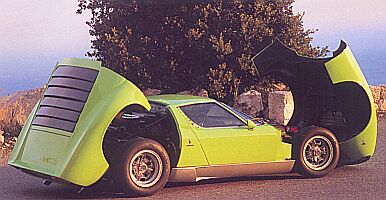 The
Miura grew out of the desire of Dallara, Wallace and Stanzani (the main
designers at Lamborghini) to go racing. They developed a new chassis with
a mid-mounted transverse engine in the hope of persuading Lamborghini to
race it. That attempt failed, but the chassis was displayed on the Lamborghini
stand at the 1965 Turin Motorshow and Lamborghini asked Bertone to design
a body for it to use as a show car.
The
Miura grew out of the desire of Dallara, Wallace and Stanzani (the main
designers at Lamborghini) to go racing. They developed a new chassis with
a mid-mounted transverse engine in the hope of persuading Lamborghini to
race it. That attempt failed, but the chassis was displayed on the Lamborghini
stand at the 1965 Turin Motorshow and Lamborghini asked Bertone to design
a body for it to use as a show car.
 When
the car entered production, it used a chassis comprising a central section,
including the floor, given strength by the large sills and centre tunnel,
and extensions front and rear for the suspension and engine and suspension
respectively. The engine was basically a 400GTV unit, with the same vertical
carburettors and 350bhp. A Sprint verion was also available with (a claimed)
430bhp - probably nearer 380. The main difference was that the transmission
housing was cast together with the crankcase, the gears being housed below
the engine in the sump. The steering adopted a rack-and-pinion layout.
The interior of the Miura reverted to the more traditional (ie rather poor)
Italian style, rather than the plush trim of previous Lamborghinis.
When
the car entered production, it used a chassis comprising a central section,
including the floor, given strength by the large sills and centre tunnel,
and extensions front and rear for the suspension and engine and suspension
respectively. The engine was basically a 400GTV unit, with the same vertical
carburettors and 350bhp. A Sprint verion was also available with (a claimed)
430bhp - probably nearer 380. The main difference was that the transmission
housing was cast together with the crankcase, the gears being housed below
the engine in the sump. The steering adopted a rack-and-pinion layout.
The interior of the Miura reverted to the more traditional (ie rather poor)
Italian style, rather than the plush trim of previous Lamborghinis.
 The
Brussels Show of 1968 saw Bertone reveal a spider version, the Roadster,
but nothing came of that project. In 1968 changes to the production model
included more power (up to 370bhp), a larger boot (due to a revised exhaust
system), new seats and a slightly improved interior, chrome trim around the windows and headlights and electric windows as standard. In this form the car
became known as the Miura S.
The
Brussels Show of 1968 saw Bertone reveal a spider version, the Roadster,
but nothing came of that project. In 1968 changes to the production model
included more power (up to 370bhp), a larger boot (due to a revised exhaust
system), new seats and a slightly improved interior, chrome trim around the windows and headlights and electric windows as standard. In this form the car
became known as the Miura S.
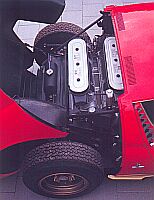 |
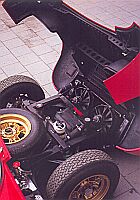 |
Technical Details
| Engine | 3929cc (82x62mm) 60deg V12 with dohc (per bank) and 350bhp @ 7,000rpm
'S' with 370bhp @ 7,700rpm 'SV' with 385bhp @ 7,850rpm |
| Suspension | front : double wishbone and coil springs plus anti-roll bar
rear : double wishbone and coil springs plus anti-roll bar wheelbase : 2500mm track (front/rear) : 1412mm/1412mm (SV : 1410mm/1540mm) |
| Brakes | discs all round with servo assistance, later cars had ventilated discs
mechanical handbrake operating on the rear wheels |
| Transmission | 5 speed manual
single plate dry clutch and ZF locking differential |
| Steering | rack-and-pinion (by ZF)
2.75 turns lock-to-lock |
| Empty weight | original - 980kg; S - 1050kg; SV - 1305kg |
The Jota
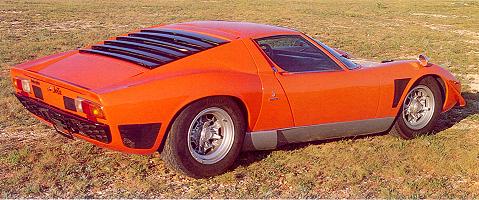 Worth
a brief mention on its own is the Jota, despite the fact that only one prototype was
built and then written-off, followed by three replicas (with less powerful
engines). It came into being as a 'private' project of Wallace's, still
keen on racing. Basically a Miura re-engineered for racing, it featured
major use of lightweight materials, including an aluminium floor and bodyshell.
The latter also featured significantly larger wheelarches to cover the
bigger wheels and tyres. The suspension featured competition style adjustable
components whilst the brakes got ventilated discs. The powertrain was modified
to separate the engine and transmission oil supplies, the former getting
a dry-sump system. Numerous other modifications were made to reduce the
weight and cope with the increased performance.
Worth
a brief mention on its own is the Jota, despite the fact that only one prototype was
built and then written-off, followed by three replicas (with less powerful
engines). It came into being as a 'private' project of Wallace's, still
keen on racing. Basically a Miura re-engineered for racing, it featured
major use of lightweight materials, including an aluminium floor and bodyshell.
The latter also featured significantly larger wheelarches to cover the
bigger wheels and tyres. The suspension featured competition style adjustable
components whilst the brakes got ventilated discs. The powertrain was modified
to separate the engine and transmission oil supplies, the former getting
a dry-sump system. Numerous other modifications were made to reduce the
weight and cope with the increased performance.

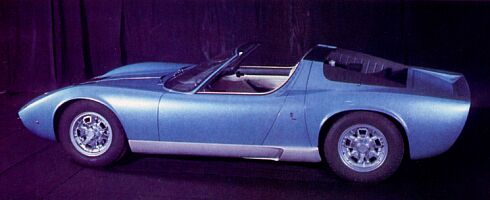 Return to the main Lamborghini page, use
the buttons at the top to navigate further, or
Return to the main Lamborghini page, use
the buttons at the top to navigate further, or